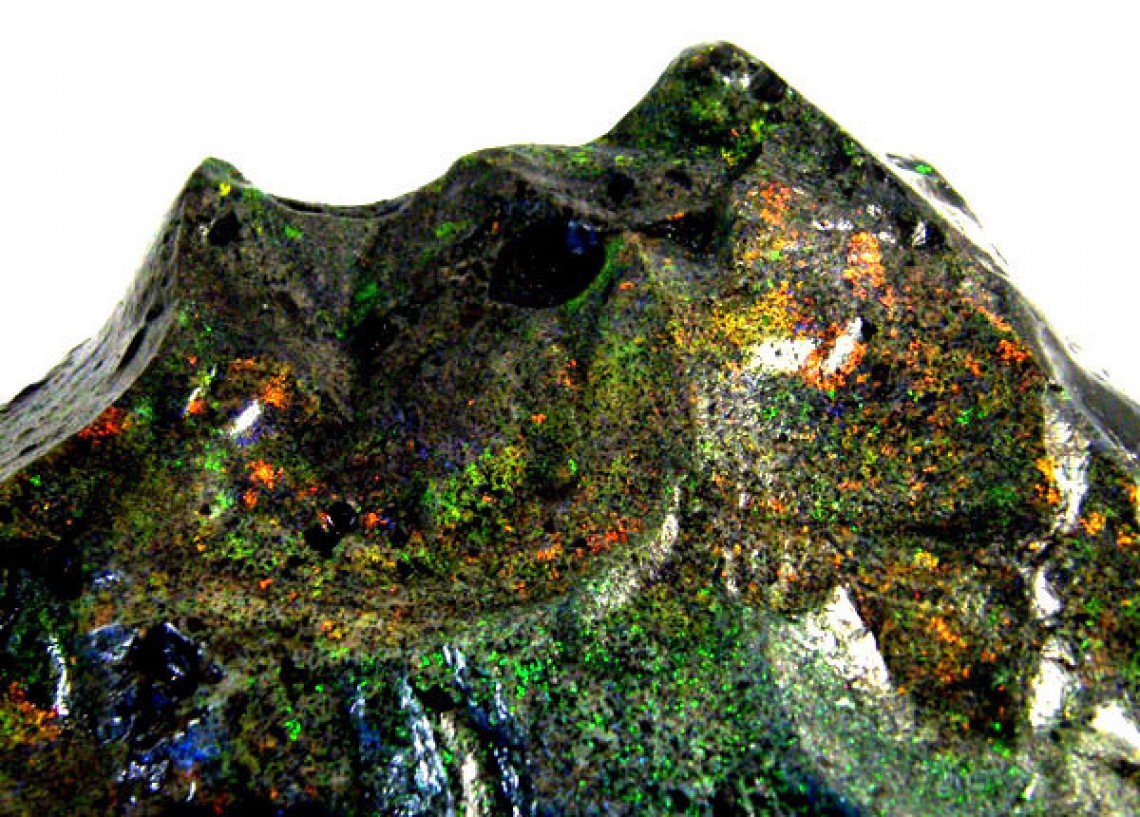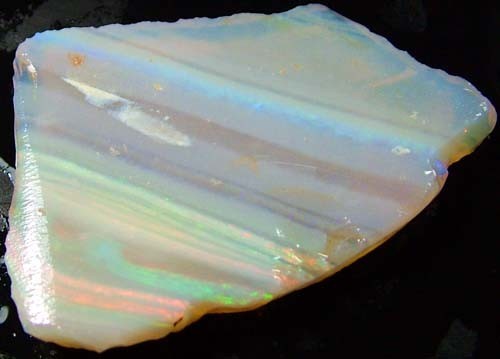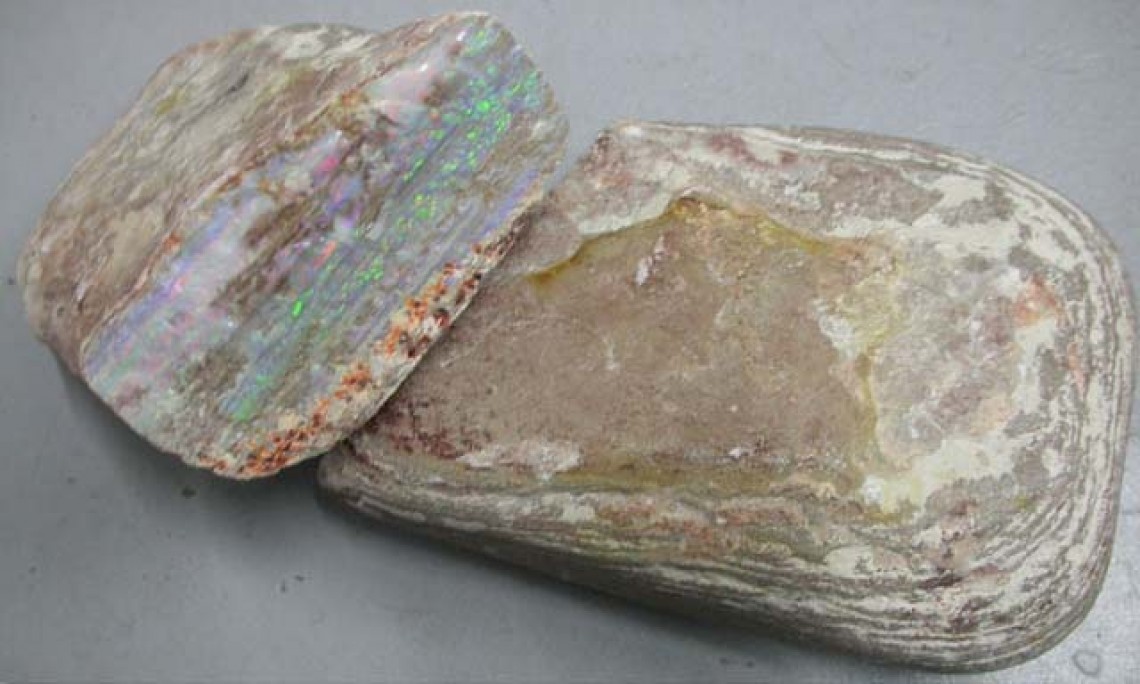
Storia dell'opale Andamooka e come trattarlo

[Tempo di lettura: 10 minuti]
Nell'Australia Meridionale, l'opale fu scoperto per la prima volta ad Andamooka negli anni '30. Il primo opale di Andamooka fu scoperto da Sam Brookes e Roy Sheppard. Sorpresi da un temporale, si ripararono sotto un albero quando una bella roccia catturò la loro attenzione. In seguito vennero alla luce depositi più piccoli, tra cui Lambina nel 1930 e Stuart Creek nel 1947. L'opale di Andamooka si trova nel sottile strato marino di "Bulldog Shale", che costituisce la porzione significativa del sottogruppo Marree del Cretaceo inferiore.
Riepilogo
Andamooka è uno dei più antichi giacimenti di opale conosciuti in Australia
Gli opali di Andamooka sono stati utilizzati nei gioielli della regina
L'opale Andomooka può essere trattato con zucchero per renderlo nero e migliorare il gioco di colori dell'opale.

Famoso opale Andamooka
L'opale Andamooka è anche noto come "Opale della Regina". Fu tagliato e incastonato in un girocollo in palladio 18 carati nel 1954. Fu donato alla Regina Elisabetta II in occasione del suo primo viaggio di Stato autorizzato in Australia. Oggi, la collana e gli orecchini sono considerati una parte importante dei gioielli della corona della Regina Elisabetta II. L'opale finale pesava 203 carati.

Scoperta nel 1930, Andamooka è considerata una delle più importanti miniere di opale d'Australia. Ha generato alcuni dei pezzi o delle serie di opali più affascinanti, come l'"Andamooka Matrix Opal", noto anche come "The Queen's Opal" di cui sopra. Il termine Andamooka deriva da un nome aborigeno che significa "Grande pozzo d'acqua". Si trova a 600 chilometri a nord di Adelaide ed è l'unica città australiana in cui nessuna strada ha un nome.

Trattamento con opale Andamooka
Le miniere di opale di Andamooka sono note per la produzione di opale chiaro, un composto bianco e cristallino, talvolta chiamato opale "latte".
L'opale Matrix è un opale permeabile, originario di Andamooka, nell'Australia Meridionale. Ad Andamooka è presente anche una varietà di opale boulder . La maggior parte della roccia circostante è quarzite, quindi a volte l'opale si forma tra queste rocce molto dure. Queste sono chiamate "donne dipinte".

L'opale matrice di Andamooka viene regolarmente trattato per migliorarne il colore creando un corpo nero utilizzando carbone nero. Questo trattamento prevede un trattamento chimico applicato all'intera pietra. Appena estratta dalla terra, può apparire piuttosto pastosa, ma trattandola con un metodo di tintura al carbone, alla fine assume un aspetto più gradevole.
Una volta completamente trattato, è noto come opale a matrice trattata Andamooka. Con una ricca soluzione di zucchero e acqua, di solito segue una fase di ebollizione in un bagno con acido solforico concentrato. Gli zuccheri penetrano nella matrice calcarea, quindi l'acido la cuoce e questo trasforma lo zucchero bianco attorno alle sacche di opale in carbone nero. Il risultato è che la matrice scura racchiude le sacche di opale, che non diffrange la luce. Alcuni minatori presero gli originali e li vendettero all'estero come opale nero Lightning Ridge. Dopo che la truffa fu scoperta, ci fu un periodo in cui nessuno avrebbe più acquistato matrici trattate. Ma i colori straordinari e la ricca matrice nera delle migliori gemme presentano effettivamente le caratteristiche che rendono famoso l'opale nero Lightning Ridge. Il trattamento di queste pietre a matrice prevede un metodo di lavorazione relativamente semplice.
 A volte viene utilizzata una resina epossidica per conferire alle pietre una splendida lucentezza. La potete trovare qui .
A volte viene utilizzata una resina epossidica per conferire alle pietre una splendida lucentezza. La potete trovare qui .

Ossa di dinosauro di Andamooka
Fossili e ossa di dinosauro sono stati rinvenuti ad Andamooka e molti sono ora esposti nei musei. I dinosauri australiani hanno un'età compresa tra 100 e 240 milioni di anni, il che li colloca nel periodo Giurassico e Cretaceo. Molti paesi hanno ossa di dinosauro, ma solo in Australia sono stati rinvenuti dinosauri opalizzati come fossili .
Prezzo dell'opale Andamooka
L'opale Matrix può avere un prezzo abbastanza ragionevole, a differenza dell'opale nero autentico. Gli acquirenti dovrebbero informarsi presso un rivenditore di opali per sapere se si sta acquistando un opale nero autentico o un opale Matrix Andamooka . 
Come trattare l'opale matrice di Andamooka
L'attrezzatura utilizzata è molto semplice. Per il riscaldamento, si usa una vecchia padella elettrica con termostato. È molto importante non surriscaldare l'opale, perché potrebbe rompersi se troppo caldo.
Mettere una miscela di 1 tazza di zucchero (bianco o di canna non sembra fare alcuna differenza) in una ciotola di Pyrex o in un'altra ciotola resistente al calore con una quantità equivalente di acqua e riscaldare finché lo zucchero non si sarà sciolto.
Per il riscaldamento, impostare la padella a una temperatura media. La ciotola in Pyrex può essere posizionata direttamente sulla padella.
Prima di trattare l'opale matrice, è necessario tagliarlo, modellarlo e levigarlo, ma non lucidarlo. L'opale deve essere asciugato accuratamente riscaldandolo leggermente per rimuovere l'umidità dai pori sottili della pietra. Evitare di toccare la pietra con le dita, poiché il sebo presente può compromettere il trattamento.
Il nocciolo o i noccioli vengono quindi immersi nella soluzione di sciroppo di zucchero e cotti per più di 8 ore. Il tempo di cottura è un po' approssimativo e dipende dalla porosità dei noccioli. Una matrice molto porosa assorbirà la soluzione di zucchero molto più rapidamente di una matrice densa. Non so come valutare quanto tempo ci vorrà, ma 8 ore mi sembrano un buon inizio.
Dopo la cottura, lasciateli raffreddare. Potrebbe essere necessario aggiungere altra acqua alla soluzione zuccherina se dovesse diventare troppo densa a causa dell'evaporazione dovuta alla cottura.
LA FASE SUCCESSIVA È MOLTO PERICOLOSA IN QUANTO PREVEDE L'USO DI ACIDO SOLFORICO ALTAMENTE CONCENTRATO. QUESTO È MOLTO CORROSIVO E ANCHE I FUMI POSSONO ESSERE PERICOLOSI.
Utilizzare acido solforico al 93% ottenuto da un fornitore di prodotti chimici.
Mettete una piccola quantità in una ciotola di Pyrex e posizionatela nella padella. La padella si trova in un capannone ben ventilato.
Quando si versa l'acido nella ciotola, si consiglia di indossare guanti di gomma e occhiali protettivi, poiché l'acido può causare gravi ustioni se schizzato sulla pelle, quindi fare attenzione. Inoltre, non versare mai l'acido in acqua, poiché reagirà violentemente e potrebbe schizzare. È preferibile utilizzare anche una maschera.
I noccioli vengono quindi rimossi con cura dalla soluzione zuccherina con una pinzetta di plastica (non di metallo, perché reagirebbero con l'acido) e poi immersi con cura nell'acido dopo aver lasciato sgocciolare la soluzione zuccherina in eccesso. Non tentare di pulire i noccioli in questa fase. I noccioli possono quindi essere cotti nell'acido riscaldato per due ore o più. A questo punto avranno cambiato colore. Possono quindi essere rimossi con cura con una pinzetta di plastica e devono essere posti in un'altra ciotola con una soluzione zuccherina diluita o una soluzione di bicarbonato di sodio. Questo serve a neutralizzare l'acido.
Dopo pochi minuti potrete ammirarli, anche se manca ancora la lucidatura finale. Una volta bagnati, potrete osservare la straordinaria trasformazione avvenuta. I colori dell'opale saranno ora chiaramente visibili.
Se la matrice era piuttosto densa, ora dovresti essere in grado di lucidare la pietra. È meglio non usare ossido di cerio o ossido di stagno, poiché il composto lucidante può penetrare nei pori e dare origine a piccole macchie bianche che possono rovinare la superficie. Per la lucidatura, utilizza una mola di cuoio con diamante di grado 50.000.
Bisogna fare molta attenzione a non applicare troppa pressione, poiché ciò genererebbe molto calore e potrebbe rompere la pietra. La matrice più porosa potrebbe non lucidarsi affatto. In questo caso, la superficie può essere ricoperta di vetro liquido per ottenere una superficie altamente lucida. Parlerò di questo trattamento in un altro articolo.
Non dimenticare di smaltire l'acido con cura. Aggiungilo all'acqua molto lentamente e poi sotterralo in giardino quando è molto diluito. Non aggiungere acqua all'acido perché schizzerà e potrebbe facilmente schizzare addosso a te, causandoti danni. In tal caso, lava abbondantemente la zona interessata con acqua. Se qualcuno ha commenti su questo trattamento o su trattamenti alternativi, non esitare a commentare. Questo processo ha funzionato per me e ho ottenuto delle pietre molto belle che assomigliano molto all'opale nero di qualità e costano molto poco in confronto.
Acquista l'opale Andamooka
Cerca il Opal Encyclopedia
Aste correlate
articoli Correlati
Tabella di conversione per le misure degli anelli
17th Jul 2018
L'opale Boulder è uno degli opali più sottovalutati sul mercato. Scopri di più su questo opale unico e scopri le splendide pietre che abbiamo in vendita.
29th May 2019
Con la passione per gli opali, Wayne ed Estella Sedawie hanno fondato Opal Plus più di 14 anni fa e hanno scoperto che internet è uno strumento prezioso. È qui che avviene la maggior parte delle transazioni internazionali dell'azienda.
17th Oct 2018
Articoli Recenti
Gli opali neri sono la varietà di opale più ricercata, con basi profonde che conferiscono un arcobaleno di riflessi alla superficie. Scopri gli usi, le proprietà, la storia e il valore degli opali neri!
7th Dec 2025
Scopri come vengono classificati gli opali e quali fattori ne influenzano il prezzo. Dal colore alla brillantezza, dal taglio all'origine, scopri come viene valutato ogni tipo di opale, con esempi di fasce di prezzo.
19th Jul 2023
Venite a scoprire il potere curativo degli opali con la nostra scrittrice ospite Vivien Schapera di Crystal Healing Techniques!
20th May 2023
Categorie di articoli
All there is to know about Opals including Black Opals, Ethiopian Opals & Boulder Opal
14 Articoli
Check out our fascinating information and articles on all things amazing in the Opal world
41 Articoli
Opal Auctions sellers who are approved as opal Verified Sellers
4 Articoli




![39.44 CTS RAINBOW ANDAMOOKA MATRIX STONES -[SEDA7881]](https://liveplatforms-production.b-cdn.net/tenants/oa/uploads/images/990000-994999/991829/5ffd2edb2422a.jpg?width=480&aspect_ratio=1001%3A1000)
![39.62 CTS RAINBOW ANDAMOOKA MATRIX STONES -[SEDA7633]](https://liveplatforms-production.b-cdn.net/tenants/oa/uploads/images/930000-934999/930099/5f508e0f6c331.jpg?width=480&aspect_ratio=1001%3A1000)

![39.87 CTS ANDAMOOKA MATRIX ROUGH SLABS [BY9623]](https://liveplatforms-production.b-cdn.net/tenants/oa/uploads/images/930000-934999/932853/5f58405598f46.jpg?width=480&aspect_ratio=1001%3A1000)